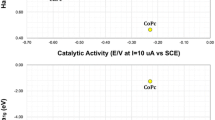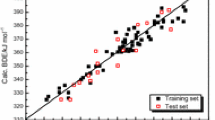Abstract
A quantitative structure–property relationship (QSPR) study was conducted to develop models to relate the structure of 46 donor compounds to their charge–transfer complex formation constants with chloranil for the first time. Donors were a diverse set of organic compounds having different functional groups. QSPR models were calculated using multiple linear regressions (MLR) and partial least squares regression (PLSR) to predict charge–transfer complex formation constants. Some important descriptors in charge–transfer complex formation were calculated and added to the descriptors taken from DRAGON software. After a reduction step using variable importance in projection, stepwise regression was employed to select the most relevant descriptors and develop the QSPR models. Results of the PLSR and MLR modeling by the selected descriptors were markedly similar. The results showed that descriptors related to nitrogen, carbonyl group, and polarizability strengthen the charge–transfer interactions.
Similar content being viewed by others
References
C. Hansch, R.M. Muir, T. Fujita, P.P. Maloney, E. Geiger, M. Streich, J. Am. Chem. Soc. 85, 2817 (1963)
C. Hansch, T. Fujita, J. Am. Chem. Soc. 86, 1616 (1964)
C. Hansch, J. Med. Chem. 19, 1 (1976)
B. Hemmateenejad, R. Miria, N. Edrakia, M. Khoshneviszadeha, A. Shafieec, J. Iran. Chem. Soc. 4, 182 (2007a)
B. Hemmateenejad, S.M.H. Tabaei, F. Namvaran, J. Iran. Chem. Soc. 4, 481 (2007b)
J. Polanski, R. Gieleciak, A. Bak, J. Chem. Inf. Comput. Sci. 42, 184 (2002)
H. Kubinyi, Drug Discovery Today 2, 457 (1997a)
H. Kubinyi, Drug Discovery Today 2, 538 (1997b)
H. Kubinyi, QSAR: Hansch analysis and related approaches, in Methods and Principles in Medicinal Chemistry, ed. by R. Mannhold, P. Krokgsgaard-Larsen, H. Timmerman (VCH, Weinheim, 1993)
A.R. Katrizky, U. Maran, V.S. Lobanov, M. Karelson, J. Chem. Inf. Comput. Sci. 40, 1 (2000)
O. Deeb, P.V. Khadikar, M. Goodarzi, J. Iran. Chem. Soc. 8, 176 (2011)
H.R. Pouretedal, M.H. Keshavarz, J. Iran. Chem. Soc. 8, 78 (2011)
G.M. Eckert, F. Gutmann, P. Keyzer, Electro Pharmacology (CRC Press, Boca Raton, FL, 1990), p. 1
H.A. Benesi, J.H. Hildebrand, J. Am. Chem. Soc. 71, 2703 (1949)
M. Hasani, A. Rezaei, Spectrochim. Acta A 65, 1093 (2006)
M. Hasani, S. Akbari, Spectrochim. Acta A 68, 409 (2007)
L. Xu, W.-J. Zhang, Anal. Chim. Acta 446, 475 (2001)
S. Wold, M. Sjöström, L. Eriksson, Chemom. Intel. Lab. Sys. 58, 109 (2001)
H. Martens, S.A. Jensen, J. Holas, A new two stage NIR calibration method, in Progress in Cereal Chemistry and Technology, Partial Least Squares Regression, ed. by J. Kratochvil (Elsevier, Amsterdam, 1983), pp. 607–647
B.M.G. Vandeginste, D.L. Massart, L.M.C. Buydens, S. de Jong, P.J. Lewi, J. Smeyers-Verbeke, Handbook of Chemometrics and Qualimetrics Part B (Elsevier, Amsterdam, 1998)
J.N. Miller, J.C. Miller, Statistics and Chemometrics for Analytical Chemistry, 5th edn. (Pearson Education Limited, England, 2005), pp. 229–231
Hypercube, Inc. HyperChem, Rel. 4 for Windows, Autodesk, Sausalito, CA, USA (1995)
L.J. Andrews, R.M. Keefer, J. Org. Chem. 53, 2163 (1988b)
L.J. Andrews, R.M. Keefer, J. Org. Chem. 53, 537 (1988a)
R.G. Parr, W. Yang, Density Functional Theory of Atoms and Molecules (Oxford University Press, Oxford, 1989)
R.G. Parr, L.V. Szentpaly, S. Liu, J. Am. Chem. Soc. 121, 1922 (1999)
R.W. Kennard, L.A. Stone, Technometrics 11, 137 (1969)
J.G. Topliss, R.J. Costello, J. Med. Chem. 15, 1066 (1972)
P. Gramatica, N. Navas, R. Todeschini, Chemom. Intel. Lab. Sys. 40, 53 (1998)
R. Todeschini, M. Lasagni, E. Marengo, J. Chemometr. 8, 263 (1994)
V. Consonni, R. Todeschini, M. Pavan, J. Chem. Inf. Comput. Sci. 42, 682 (2002)
Author information
Authors and Affiliations
Corresponding author
Rights and permissions
About this article
Cite this article
Shariati-Rad, M., Hasani, M. QSPR study of charge–transfer complexes of some organic donors with p-chloranil using PLSR and MLR. J IRAN CHEM SOC 9, 19–25 (2012). https://doi.org/10.1007/s13738-011-0004-0
Received:
Accepted:
Published:
Issue Date:
DOI: https://doi.org/10.1007/s13738-011-0004-0




